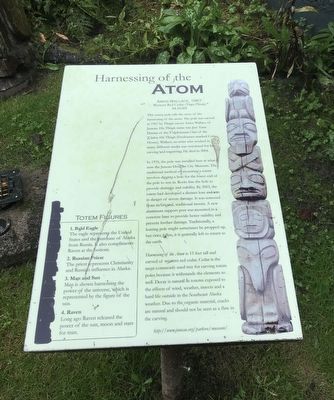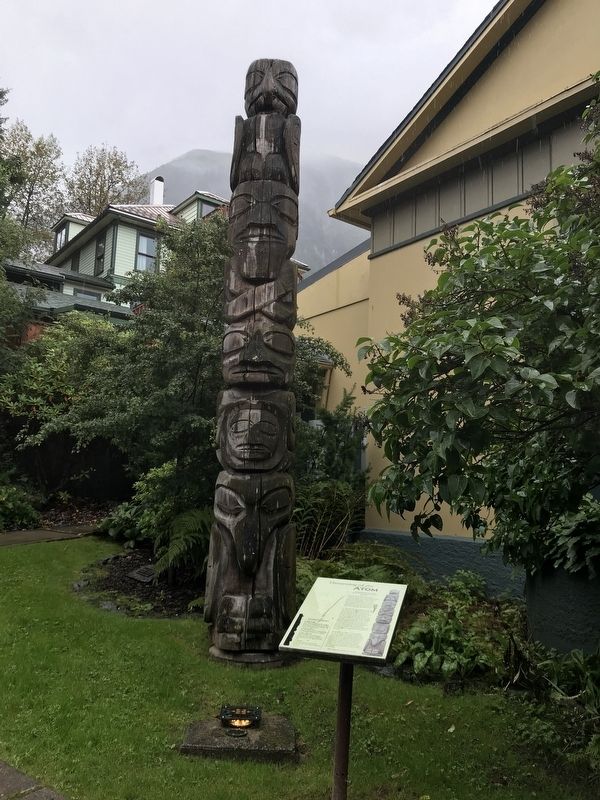Downtown Juneau in Juneau Borough, Alaska — Northwest (North America)
Harvesting of the Atom
Amos Wallace, 1967
— Western Red Cedar (Thuja Plicata) —
In 1976, the pole was installed here at what is now the Juneau-Douglas City Museum. The traditional method of mounting a totem involves digging a hole for the lower end of the pole to rest in. Rocks line the hole to provide drainage and stability. By 2003, the totem had developed a distinct lean and was in danger of severe damage. It was removed from its original, traditional mount. A new aluminum support post was mounted in a concrete base to provide better stability and prevent further damage. Traditionally, a leaning pole might sometimes be propped up, but once fallen, it is generally left to return to the earth.
Harnessing of the Atom is 15 feet tall and carved of western red cedar. Cedar is the most commonly used tree for carving totem poles because it withstands the elements so well. Decay is natural in totems exposed to the effects of wind, weather, insects and a hard life outside in the Southeast Alaska weather. Due to the organic material, cracks are natural and should not be seen as a flaw in the carving.
Totem Figures
1. Bald Eagle The eagle represents the United States and the purchase of Alaska from Russia. It also compliments Raven at the bottom.
2. Russian Priest The priest represents Christianity and Russian influence in Alaska.
3. Man and Sun Man is shown harnessing the power of the universe, which is represented by the figure of the sun.
4. Raven Long ago Raven released the power of the sun, moon and stars for man.
Erected by Juneau-Douglas City Museum.
Topics. This historical marker is listed in these topic lists: Arts, Letters, Music • Communications • Native Americans • Science & Medicine. A significant historical year for this entry is 1967.
Location. 58° 18.101′ N, 134° 24.693′ W. Marker is in Juneau, Alaska, in Juneau Borough. It is in Downtown Juneau. Marker is at the intersection of Calhoun Avenue and West 4th Street, on the right when traveling north on Calhoun Avenue. Marker and totem pole are at the Juneau-Douglas City Museum. Touch for map. Marker is at or near this postal address: 114 W 4th Street, Juneau AK 99801, United States of America. Touch for directions.
Other nearby markers. At least 8 other markers are within walking distance of this marker. 4-Story Totem (within shouting distance of this marker); Calhoun Ave. Overpass (within shouting distance of this marker); William Henry Seward (within shouting distance of this marker); Seward & Alaska (within shouting distance of this marker); a different marker also named William Henry Seward (within shouting distance of this marker); Liberty Bell Reproduction (about 300 feet away, measured in a direct line); Bishop Michael H. Kenny (about 500 feet away); The MacKinnon Apartments (about 700 feet away). Touch for a list and map of all markers in Juneau.
Also see . . . Tlingit carver Amos Wallace (YouTube). In 2012, Brian Wallace donated a collection of his father's drawings, photographs and documents to Sealaska Heritage Institute. His father, Amos Wallace, was a very well-known Tlingit carver who helped to carry on the tradition of Tlingit carving in the mid-twentieth century. Uploaded April 5, 2021. (Submitted on September 13, 2021, by Duane and Tracy Marsteller of Murfreesboro, Tennessee.)
Credits. This page was last revised on September 13, 2021. It was originally submitted on September 13, 2021, by Duane and Tracy Marsteller of Murfreesboro, Tennessee. This page has been viewed 257 times since then and 41 times this year. Photos: 1, 2. submitted on September 13, 2021, by Duane and Tracy Marsteller of Murfreesboro, Tennessee.

